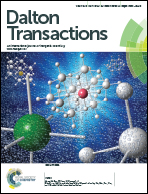Active layer solution-processed NIR-OLEDs based on ternary erbium(iii) complexes with 1,1,1-trifluoro-2,4-pentanedione and different N,N-donors†
Abstract
Using a fluorinated 1,1,1-trifluoro-2,4-pentanedione (Htfac) ligand and either 2,2′-bipyridine (bipy), bathophenanthroline (bath) or 5-nitro-1,10-phenanthroline (5NO2phen) as an ancillary ligand, three new ternary erbium(III) octacoordinated complexes have been synthesized. The single crystal structures of the new complexes (namely [Er(tfac)3(bipy)], [Er(tfac)3(bath)] and [Er(tfac)3(5NO2phen)]) have been determined and their properties have been investigated by Fourier transform infrared (FTIR) spectroscopy, Raman spectroscopy and thermodynamic analysis. After ligand-mediated excitation of these complexes in the UV, they all show the characteristic near-infrared (NIR) luminescence of the corresponding Er3+ ion at 1532 nm. The same emission in the C-band transmission window can also be obtained from the solution-processed organic light-emitting diodes (OLEDs) with structure: glass/ITO/PEDOT:PSS/[Er(tfac)3(N,N-donor)]/Ca/Al. In spite of the fact that the photoluminescence intensity of [Er(tfac)3(5NO2phen)] is stronger than those of [Er(tfac)3(bipy)] and [Er(tfac)3(bath)], the best electroluminescence results correspond to the OLED based on the [Er(tfac)3(bath)] complex, as a consequence of the superior electron transport capabilities of bathophenanthroline.



 Please wait while we load your content...
Please wait while we load your content...